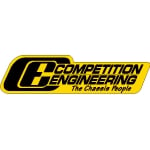- Steering & Suspension
- Chassis, Roll Cage, Frame Rail, Subframe & Front Suspension Kits
- Competition Engineering Rear Frame Rails
Unmatched Rear Chassis Strength
Competition Engineering Rear Frame Rails replace the stock rails in subframe-equipped cars, eliminating the chance of bending and twisting under higher horsepower strain. Each rail is mandrel-bent on a computer-controlled machine to remove kinks and wrinkles often found in other frame rails. Only the finest mild steel tubing is used to guarantee unequaled strength and weight savings. Please note that some welding is required for installation.
GM
Competition Engineering Formed Rear Frame Rails 1962-1967 Chevy II (excludes Wagon)
Competition Engineering Formed Rear Frame Rails 1968-1976 Chevy Nova/Omega/Ventura II/Apollo
Universal
Competition Engineering Universal Rear Frame Rail Kit 4-Link Suspension
Competition Engineering Universal Rear Frame Rail Kit Ladder Bar Suspension
What Are The Top Competition Engineering Rear Frame Rails And Kits?
The most popular rear frame rails available from Competition Engineering are the Universal Frame Rails For 4 - Link Suspensions. These rails are designed to fit any vehicle and require modification in order to properly be installed. The next most popular rear frame rails fit 1970 -1981 GM F-Body, including Chevrolet Camaro and Pontiac Firebird. The third most popular Competition Engineering rear frame rails fit 1962 – 1967 Chevy II / Nova (except for station wagon models).
How Much Do Competition Engineering Rear Frame Rails Cost?
Competition rear frame rail kit options range in price from around $375 for 1968 - 1976 Chevy Nova/Omega/Ventura II/Apollo to over $1600 for a rear frame rail and ladder bar suspension kit.
What Are The Main Benefits of Competition Engineering Rear Frame Rails?
The rear frame rails offered by Competition Engineering are designed to be used in place of the original rails, with stronger material and construction. This reduces bending and twisting that can result from high-horsepower use in drag racing. This helps keep your racecar going straight on the track.
How To Install Competition Engineering Rear Frame Rails
The steps to install rear frame rails will change depending on the year, make, and model of the vehicle. The detailed instructions included in each kit must be followed for proper assembly. In general, the first step is raising the vehicle off the floor safely to allow room for the removal of the original rails and installation of the Competition Engineering rails. Next, all components that are in the way of removal and installation need to be disassembled and removed. A lot of measuring and planning is required that includes confirming the vehicle wheelbase and desired ride height, as well as proper leveling of the vehicle and plumbing and marking critical points on the floor. The vehicle body needs to be secured and supported at the rear to prevent sagging caused by the removal of the original frame rails. The rear axle housing and suspension is then removed. After careful measuring and planning, the floor above the frame is cutout to gain access to the top of the frame. The frame is then cut and removed from the vehicle. The new frame is then measured for length and cut if needed. With additional careful planning and measuring, the frame is then welded into place. Any additional brackets or mounts are welded to the new frame next. The floor pan is then welded back in place and the suspension and axle housing are reinstalled. Once everything is assembled, tuning and adjustments will need to be made to the vehicle suspension to confirm correct vehicle handling and ride.
